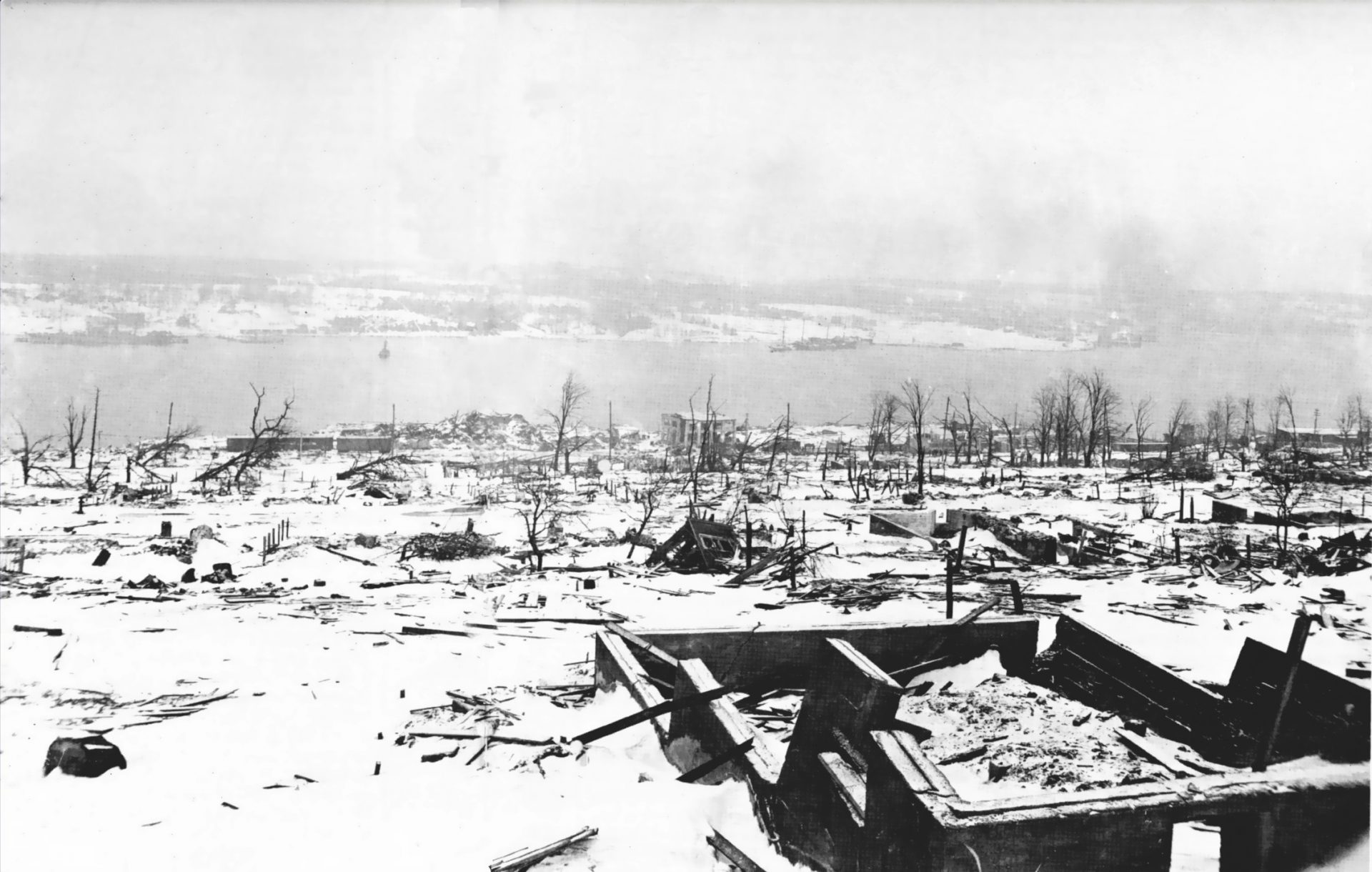Halifax Nova Scotia, on Canada’s Atlantic coast, was a bustling harbour city during the Great War.
The harbour hosted ships from all over the world, often acting as a gathering point for convoys from the United States and Canada, and from as far away as Europe. During wartime, the harbour protected itself from enemy spies, torpedoes, and other attacks, by raising a torpedo net around the entrance at night.
The French cargo ship, the SS Mont-Blanc, was enroute from New York to Bordeaux, France via Halifax, carrying cargo and materials to be used in weapons of war. This included nearly 3,000 pounds of highly combustible munitions, such as picric acid, TNT, gun cotton, and benzol, a coal-tar product often used in high octane gasoline.
The Mont-Blanc arrived in Halifax late on December 5th, fully loaded with explosives and fuel. Prior to the war, she would be required to don a red flag, indicating that there were dangerous materials on board and would be restricted from entering the harbour. However, the fear of attacks by German submarines meant the lifting of many wartime restrictions, allowing the ship to enter the harbor and remain in port unflagged.
A Norwegian vessel, the SS Imo, captained by Haakon From, was also in Halifax undergoing inspections while transporting humanitarian supplies to German-occupied Belgium. The Imo had been given departure clearance on December 5th, but was delayed due to the late arrival of coal, remaining in port till the next morning with the raising of the torpedo nets overnight.

Early on December 6th, the Mont-Blanc entered the strait, called The Narrows, to join a slow-moving convoy bound for France. At the same time, Imo enters the Narrows on the opposite end.
Another steam ship manoeuvres too close to the Imo, and both pilots, using horn signals, agree to pass each other on the right side. While this may seem logical, it goes against the rules of navigation and this decision puts Imo in the path of oncoming ships.
A tugboat was next to come across Imo, forcing her to stay in the wrong lane to avoid collision, unfortunately, this proved the wrong decision, as Imo was now on a direct collision course with the Mont-Blanc.
The Mont-Blanc signaled to the Imo to move over, but she would not yield. Typically, the ship carrying dangerous cargo would have the right of way, but since no warning flag was flown, Imo’s captain was unaware of its cargo.
At the last second, both ships cut their engines, and Imo went theirs into reverse, but the forward momentum could not be halted and the ships collided. Even though the Imo ripped a 3-metre-long gash in the side of Mont-Blanc, the collision itself was relatively minor, as the ships were moving at a slow speed of about 1 knot, or about 1.15 mph. However, the sparks created by metal-on-metal friction, instantly ignited damaged barrels of flammable bezol in the Mont-Blanc’s hold.
Knowing the extreme danger of the situation, Mont-Blanc’s captain ordered his crew to abandon ship as it drifted towards one of Halifax’s piers. Crewmen attempted to alert people on shore, but the spectators had no idea that they were staring at a ticking bomb.
Less than 20 minutes after the collision, the Mont-Blanc exploded in a blinding white blast, destroying most buildings in a half mile radius. The resulting pressure wave, traveling at approximately 3,300 feet per second, bent iron rails, snapped trees, and grounded several ships (including the Imo) due to a 60-foot tidal that followed.
Temperatures near the blast point reached about 9,000 degrees (F), incinerating everything in the vicinity, and vaporizing people where they stood. Around 1,600 people were killed instantly, and another 300 later died from their injuries. Over 9,000 people were injured, and 25,000 were rendered homeless. The most common injury was to the eyes, with many ultimately blinded from the white blast.
Secondary fires erupted all over town from overturned stoves igniting, and emergency crews were quickly overwhelmed. Help would come from the surrounding areas, but the quickest came from an unlikely place.
Boston, Massachusetts and Halifax historically had a strained relationship…Nova Scotia was where thousands of British loyalists from New England fled after the end of the American revolution.
However, Boston did not hesitate to ship essential supplies to Halifax. By 10:00pm on the night of the explosion, a train was on its way to Canada carrying food, water, medical supplies, and medical professionals who would assist in the coming days.
Halifax was so moved by Boston’s unwavering support, that the following December they sent a Christmas tree to Boston as a thank you. The yearly tradition started in 1971 and continues to this day, in acknowledgement of Boston’s assistance during Halifax’s most tragic day.
The tree is Boston’s official tree and sits proudly in Boston Common throughout the holiday season.
Written by Julie St Jean





